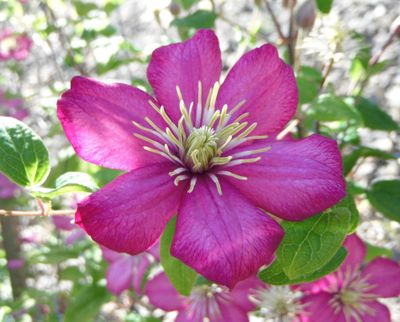Gardening: Show explores the variety of clematis

A sure sign that spring has come in my yard is the blooming of a wonderful clematis a friend gave me years ago. She didn’t know the name of it, but she promised me I wouldn’t be disappointed. I wasn’t. I planted it on the east end of the garage where its roots would be cool but its leaves could reach the sun. Every spring around Mother’s Day its pale pink, bell-shaped flowers come out and cover the vine. The honey bees just love it.
One of the things that make clematis special is that with a little attention to their needs just a few plants climbing through other shrubs can put on a big show in the garden from early spring into the fall. They are the perfect plant to cover up fences, boring hedge plantings and even an ancient lilac to two.
On Saturday, Spokane gardeners will have a special opportunity to explore the world of clematis at the Quest for Clematis at Northern Quest Resort and Casino. Sponsored the Friends of the Rogerson Clematis Collection, this will be an opportunity to learn about some of the more than 250 species of clematis and numerous garden hybrids. The Rogerson collection is one of the country’s premier clematis collections and is located in Lake Oswego, Ore.
The morning portion of the program will feature an early bird sale of species and garden hybrids followed by two talks by Linda Beutler, well-known Portland-based garden writer and curator of the collection. Beutler will speak on cold climate clematis and using clematis with companion plants in the garden.
There is a donation of $8 for the morning sale and lectures. In the afternoon, the sale will be free and open to the public with not only clematis for sale but also hardy, own-root roses from Northland Rosarium and handmade iron sculptures and garden art by Billie Bellinger.
Most of the most popular deciduous varieties are hardy here. Clematis need only a couple of things to do well in Inland Northwest gardens: their roots in cool soil and their heads in full sun. To meet these needs, plant them in the shade of low growing shrubs and then give them a trellis or tall shrub to climb up. The planting hole needs to be deep and the soil amended with compost. The crown of the plant should be planted two to three inches below ground and watered deeply every week. Planting the clematis deep helps the plant overcome a common wilt that can kill top growth.
Most clematis do better with some annual pruning. However, timing that pruning depends on when your clematis bloom. Early spring and summer bloomers bloom on last year’s wood and should be pruned right after they finish blooming. Late summer and fall bloomers grow on new wood so they can be pruned in the winter. There is a third class that blooms on new and old wood. These can be pruned early after the first flush and then again in the fall.